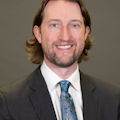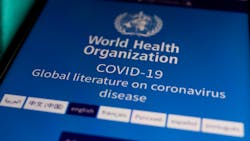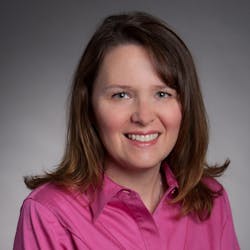Clarifying the WHO guidance on dental care during COVID-19: An interview with Dr. Julie Hawley
On August 3, 2020, the World Health Organization (WHO) published a guidance for the administration of oral health care during COVID-19. Shortly thereafter, US media began to report that the WHO had recommended delaying "non-essential" dental care during the pandemic. From there, it wasn't long before dental associations from A to Z began issuing statements that chided the WHO for its recommendation.
But was this much ado about nothing? Upon further review, the WHO guidance may have been more nuanced than initially reported. I had a chance to speak with Julie Hawley, PhD, CAE, the director of analytics and evaluation at the DentaQuest Partnership for Oral Health Advancement, about the origins of the WHO controversy. Dr. Hawley and her colleagues are seeking to clarify the guidance, as its misinterpretation may be causing patients to delay dental care unnecessarily. I also spoke with Dr. Hawley about how dental professionals could make sense of the many competing recommendations that have been published to date.
Here's what Dr. Hawley had to say.
Interview with Dr. Julie Hawley
ZK: The recent WHO guidance for dental care during COVID-19 was met with unfavorable reviews by many dental professionals and associations in the US. However, there are others who believe the WHO guidance was widely misinterpreted, which led to unnecessary alarm for patients and providers. Can you explain the nature of the controversy and how the DentaQuest Partnership for Oral Health Advancement is seeking to clarify the WHO guidance for the benefit of the dental community?
We know how important preventive oral health care is to overall health, and we didn’t want people to view the WHO guidance as an all-out ban on preventive dental visits in the US. Rather, the WHO guidance is intended for countries that do not have the same infrastructure to provide national and state-specific guidance. In the US, we are fortunate to have resources that provide more detailed and tailored guidance based on local conditions. Ultimately, the decision about when and how to return to the dentist for preventive care is one that needs to be made by individuals, and unnecessarily delaying preventive care can lead to longer term oral health—and overall health—problems.
ZK: There are a number of organizations that have attempted to provide assistance to the dental community during the COVID-19 pandemic. This has created challenges for dental practitioners and health-care decision makers, as sometimes recommendations appear incongruent with one another. What do you feel have been the primary challenges in reaching the dental community and providing leadership in these uncertain times, and how have DentaQuest and others tried to meet those challenges?
Dr. Hawley: During the pandemic, there has been a lot of great work done to address what is and is not permitted and how care can be delivered safely, but it’s not always easy to understand, and we’re operating in a fluid and changing environment. The CDC, the federal Occupational Safety and Health Administration, the American Dental Association, and the American Dental Hygienists’ Association have all developed and are frequently updating individual guidance, and it’s not easy for providers to keep up with it all.
Rather than developing our own guidance, the DentaQuest Partnership saw an opportunity to help providers easily stay up to date with all the latest information from these agencies. We worked with the Organization for Safety Asepsis and Prevention, the leading expert organization in infection control in dentistry, to collate all of the guidance disseminated by these organizations and develop a comprehensive set of best practices for dental providers to ensure a safe return to preventive dental care for all. Together, we developed straightforward checklists addressing all the major aspects of safely engaging in dental practice during the COVID-19 pandemic. These best practices are continually updated to reflect all changes in guidance, so providers can be assured that they are up to date. And so that patients could benefit from the same information, we developed a similar companion piece for patients.
We also expanded our webinar series and online learning center to support dentists’ return to work, including the development of a new COVID-19 education series that includes the following free courses:
- Infection Control and Preventive Care During a National Health Care Crisis
- Teledentistry: Providing Alternative Care During a Public Health Crisis
- Infection Control: Questions & Answers About COVID-19
- Saliva and COVID-19 Testing in Clinical Dental Practice
- Best Practices for Infection Control in Dental Clinics
During the pandemic, we’ve seen increased registration counts and participation in these offerings, which come with free continuing education credits and are easy for dentists to access.
ZK: As we approach the sixth month of the pandemic in the United States, what do you believe are the critical issues for dental professionals going forward? Put another way, has the pandemic created any opportunities to rethink how the dental profession can improve itself?
Dr. Hawley: The pandemic has made a huge impact on all industries, and dentistry has been hit particularly hard. While things were very tough, especially in the early days, difficult challenges can inspire new ways of thinking and operating. And we need to seize this opportunity to not just adapt, but to innovate. Because in dentistry, there is no "back to normal."
The pandemic moved telehealth along by almost a decade, and teledentistry is no exception. We’ve seen a lot of movement toward implementing more teledentistry approaches to improve access to care and address health equity. Our research shows that consumers and providers are using teledentistry and appreciate the flexibility it offers. Now that many have gotten a taste of what teledentistry can provide, the momentum is in place to keep and expand it. Patients like it. Providers like it. It’s here to stay.
Another positive change we’re seeing is more movement among providers and health-care systems toward alternative payment models. The early days of the pandemic revealed a gap in the standard payment structure, where a provider is paid for services delivered. Because dental practices were largely restricted to providing only emergency and urgent care, income was significantly reduced. This has resulted in greater interest in value-based care as an alternative payment model, where the provider’s income is largely based on keeping patients healthy, rather than the number of procedures they complete. This type of approach allows providers to leverage alternative ways of managing patients, such as teledentistry, focusing on minimally invasive and nonaerosol generating procedures, and then beginning to engage in more comprehensive care.
ZK: Where can dental professionals go for more helpful information?
Dr. Hawley: We have a lot of great COVID-19 resources for providers, including research reports, whitepapers and training at dentaquestpartnership.org. Providers can also sign-up to receive our monthly e-newsletter.
About the interviewee:
Julie Hawley, PhD, CAE, is the Director of Analytics and Evaluation at the DentaQuest Partnership for Oral Health Advancement, a nonprofit organization working to transform the broken health care system and enable better health through oral health. In this role, she is responsible for creating and implementing a strategy to transform data into knowledge that can be used to elevate oral health’s visibility, inform policy, care, community, and financing system decisions, and increase awareness about the DentaQuest Partnership’s impacts.
Zachary Kulsrud is the editorial director for Endeavor Business Media's dental group, publishers of Dental Economics, DentistryIQ, Perio-Implant Advisory, and RDH magazine.
About the Author

Zachary Kulsrud
Zachary Kulsrud is the editorial director for Endeavor Business Media's dental group, publishers of Dental Economics, DentistryIQ, Perio-Implant Advisory, and RDH magazine.
Updated July 7, 2020

